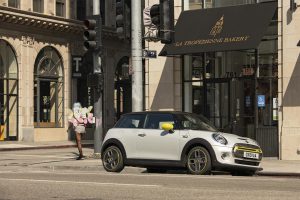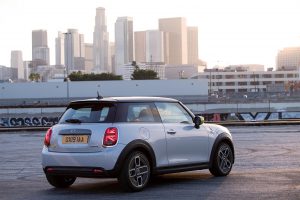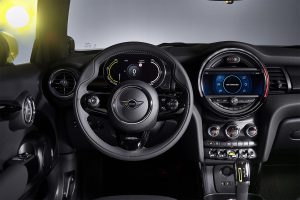British brand Mini has been teasing us for years with plans to bring an all-electric vehicle to market, even putting a prototype into limited distribution earlier in the decade, ostensibly to get customer feedback. Now, finally, the BMW subsidiary is ready to plug in, with the Mini Cooper SE about to start rolling out to dealers around the world.
Mini hasn’t made a secret of its plans to launch the SE, but it is just now offering key details. Most details, anyway. We’ll have to wait to learn the precise timing of its U.S. on sale date, for one thing, as well as pricing and range.
What we do know is that using the latest European WLTP cycle, it is expected to deliver 235 to 270 kilometers per charge, or 146 to 168 miles. We can expect that number to dip a bit once the EPA comes out with its own ratings.
Even with the (likely) higher figure, the question is whether than will be enough to generate enthusiasm in a market where industry analysts find the real tipping point is closer to 200 miles – and where some manufacturers, such as Tesla, are pushing up to 300 miles and beyond.
(Mini Electric Tows a 150-Ton Boeing Jet)
If we had to guess what the Mini Cooper SE will actually deliver in the U.S. we’d likely bet on something around 153 miles per charge – at most. That’s the current limit for the BMW i3 which was updated for the 2019 model-year from a previous 115 miles range.
The comparison makes sense when you consider the new Mini Cooper SE, despite looking pretty much just like the current, gas-powered Mini Cooper actually relies on the same underlying platform as the BMW i3. A key difference is that it doesn’t make use of the super-light carbon fiber body panels of the Bavarian battery-car, something that further limits range.
Under the skin, the British battery-electric vehicle, or BEV, relies on a 32.6 kilowatt-hour battery mounted under its floorboards. That means it doesn’t sacrifice interior or cargo space, though its body does sit almost an inch higher than a stock Mini Cooper.
Other than that, it looks much like a conventional Mini, inside and out. There are some cues that the SE is electric, however, including various yellow accents, including a decorative bar crossing the grill and mirror caps. The grill, as we’ve seen with a number of new BEVs, is largely sealed off because of the much lower need for cooling air on an electric vehicle.
(Here’s What Mini’s 1st EV Will Really Look Like)
Inside, the gauge cluster has special displays for tracking, among other things, the battery’s state-of-charge. The SE offers a higher level of standard content than the Mini Cooper S, including LED headlamps, a twin-zone auto climate system, and onboard navigation that also helps a driver track down nearby charging stations.
The hatchback is powered by a single electric motor driving the front axle. It produces 184 horsepower and 199 pound-feet of torque. The gas-powered, or ICE, Mini Cooper turns out 134 hp and 162 lb-ft, the Cooper S bumping that up to 189 hp and 207 lb-ft. A news release from the British marque says the all-electric SE will hit 100 kmh, or 62 mph, in 7.3 seconds, a tenth of a second quicker than the Cooper, but nearly a full second slower than the Cooper S, so buyers won’t be in for the sort of aggressive launches that some of the newer BEVs are delivering.
On the other hand, the automaker notes, the low positioning of both the motor and battery pack does offer some advantages, its news release pointing out that, “Along with the lower center of gravity, this gives the electrically powered model agile handling, making it supreme and easy to control even when cornering at high speed.”
As for charging, the battery is small enough to plug in and get back to running relatively uicky, especially when using a Level 3 Fast Charger. It can only handle a maximum 50 kW but that’s enough for an 80% recharge in 35 minutes, the automaker says. It also can plug into a 120 volt socket, if nothing is available, though for home and office use a Level 2, 240-volt system is preferred. Charging times for the 7.4 kilowatt system weren’t released but should be something on the order of four or five hours, based on what vehicles with similar-sized batteries require.
(Mini Shows Off Battery-Electric Concept at Goodwood)
As for pricing, the 2020 Mini Cooper SE will start at $32,500 euros in Germany, or around $36,400. Meanwhile, the automaker plans to begin rolling the BEV into dealers “as early as possible.” According to Mini Senior Vice President Bernd Koerber, though it will stagger the launch, depending upon the market. No word on where the U.S. stands in the roll-out schedule.




